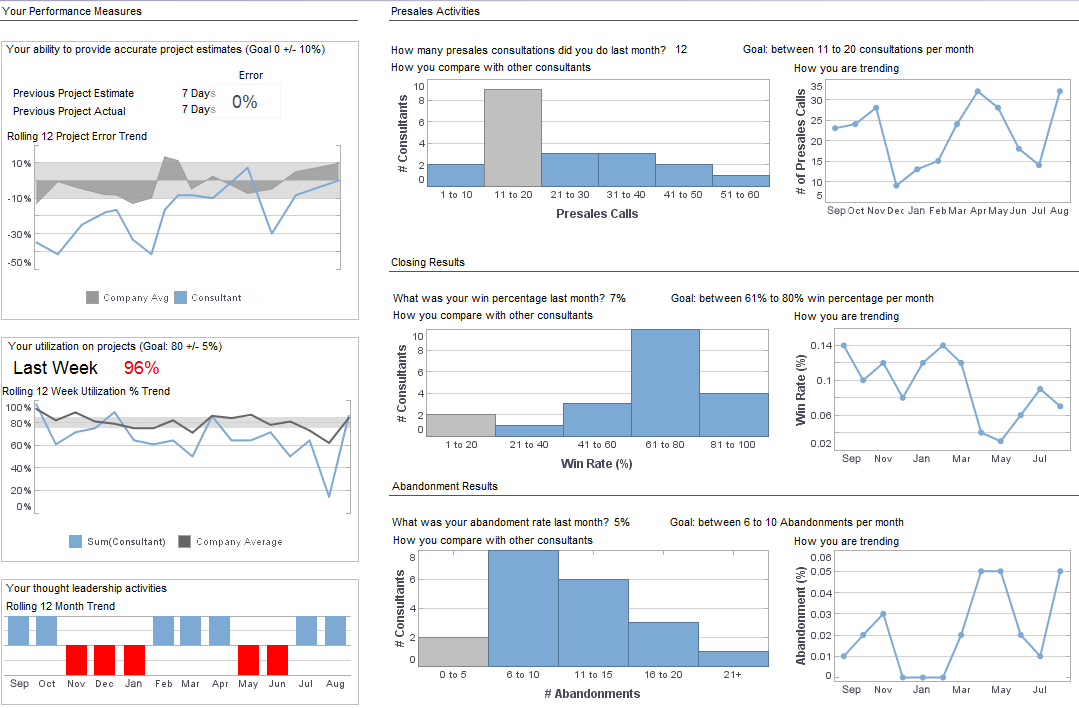What are the Benefits of a Visual Reporting Solution?
This is the transcript of a Webinar hosted by InetSoft on the topic of "What are the Benefits of a Visual Reporting Solution?" The speaker is Abhishek Gupta, Product Manager at InetSoft.
Welcome to our webinar today on “What are the Benefits of a Visual Reporting Solution?” Today we’re going to focus on visual reporting and analysis, what is it, what benefits does it provide? We’re going to summarize some of key research points and then go to three examples of such an application. First we’ll look at an example with a top college, second with a major airline, and third with work with a salesforce.com pipeline analysis.
Just for your information we will of course have some time for question and answers at the end of the webinar, and there are several ways that you can get your questions to us. You can use the chat panel that you see in the right hand corner of your Gotomeeting screen, or if you are into tweeting you can use our Twitter hashtag #inetsoftviz, or you can feel free to raise your hands, and we can unmute.
You can ask your question live, or wait until the the end of the webinar. And the all important question will the webinar and slides be available afterwards? Yes we’re recording the webinar, and we will make both the webinar and slides available on our website.
 |
Read how InetSoft saves money and resources with deployment flexibility. |
Solving the Cycle of Pain
So let's jump into the content. This is going to last about 30 minutes, and then we’ll have a Q&A session at the end of that. So the main problem and its related that a visual reporting tool covers is what we call the “Cycle of Pain,” which comes in two forms. The first is the custom report request, and we see all the time with our clients that an end-user group or end-user has some question.
They submit a request to IT who runs some queries on one of the databases and gives a report back. Usually there is a backlog, so it’s a week or two before it comes back. The report begs another question because maybe the data doesn’t show exactly what they thought it would, so they modify the question, and it goes back through the cycle. It is hard to collaborate that way, and it's creates a lot of frustration on both sides.
The other form of the cycle of pain we see all the time is downloading data into excel extracts which is usually formatted into one table. You slice and dice, it but it's hard to slice and dice across a lot of parameters in excel. It’s time consuming. You don't have all the data because some of some of it's in another table that you didn’t get.
It’s hard to show management the analysis. You’ve got the spreadsheet. They ask new a question, but this means you have to re-cut your data. It's just not easy to do. And one of the worst things we see is this spreadsheet ends up becoming a shadow data system since it's hard to get this data in the first place.
Three months later you are still working with the same data, but it's now dated because time has progressed. So that's I think these are main issues that visual reporting and analysis is aimed at addressing. And the first thing it does is if you look at this as a model of data, there’s a set of different tables, typical business problems, a demographic table that might be a list of customers.
It might contain some addresses. There might be some other descriptive tables and maybe other ratings and scores. They’ve been sent different promotions overtime in different forms, and they’ve done different kinds of transactions maybe the website and maybe through the sales team.
The first thing that these new approaches do is they bring the data into memory so a big part of this is in memory data management solution. Then the tables are linked together so they basically become an integrated interactive unit. This could be one case that might be in one excel sheet. So it could be one table. Or in some cases it might be 100 tables that get loaded from an Oracle database every night.
The beauty of this is one of selection is made maybe on a set transactions in the transactions table. It updates the customer table for the people who made those transactions. It updates the promotions tables for the people who had those transactions or who got those promotions. You can select a set of promotions which is then intersecting the people who got the promotions with the kinds of purchases they made, and you’ve got a list of all the people across all the tables.
 |
Read why choosing InetSoft's cloud-flexible BI provides advantages over other BI options. |
This enables easy answers to questions and on top of the memory pool, what we are doing is running a very strong visualization capability that not only shows the data across all these tables but also let you interact with it. Just by clicking and selecting what you see on the screen, you explore the data. This is instead of going back and doing queries against the data.
It’s in memory, and those queries are all happening behind the scenes or under the covers. We’re going to take a look at just a minute, our first case a major university. A question they might actually have is ‘do we have the top rated prospects for fund raising?’ Who are they? What might we do to get more fund raising out of those people?'
| Previous: Example of an Advanced Visualization |
Next:
Mobile BI
|
